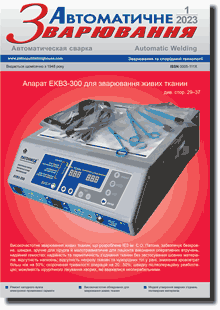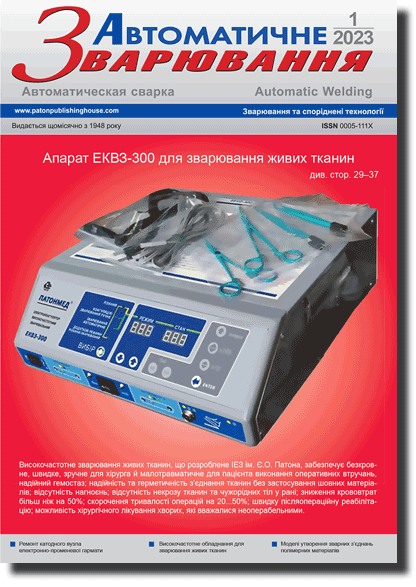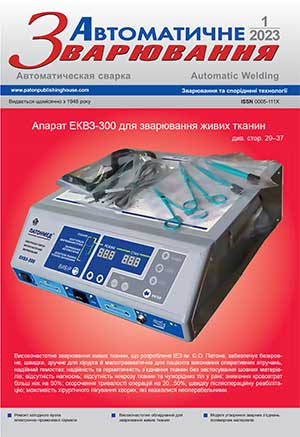| 2023 №01 (05) |
DOI of Article 10.37434/as2023.01.06 |
2023 №01 (07) |

Журнал «Автоматичне зварювання», № 1, 2023, с. 38-46
Методи запобігання ефекту екранування напружень в системі імплантат–кістка (Огляд)
А.В. Молтасов1, С.Г. Войнарович1, М.М. Димань1, С.М. Калюжний1, С.В. Бурбурська2
1ІЕЗ ім. Є.О. Патона НАН України. 03150, м. Київ, вул. Казимира Малевича, 11. E-mail: office@paton.kiev.ua2OSTEONIKA Limited Liability Company. 79026. м. Львів, вул. Стрийська, 98. E-mail: ito3dlab@gmail.com
Статистичні дані багатьох національних реєстрів та медичних співтовариств свідчать про те, що асептична нестабільність протеза кульшового суглоба є однією з основних перепон на шляху до використання ортопедичних імплантатів. Однією з причин асептичної нестабільності є виникнення ефекту екранування напружень, який зумовлений невідповідністю модулів пружності імплантату та кісткової тканини. Розглянуто методи, які дозволяють знизити модуль пружності металевого імплантату з наближенням його до відповідності модуля пружності кісткової тканини. Встановлено, що досягнення поставленої задачі шляхом заміни традиційних металів, що використовуються для виготовлення імплантатів, сплавами зі значно нижчим модулем пружності є технологічно невирішеним завданням при їх масовому виробництві. Проаналізовано найбільш розповсюджені на сьогодні методи зниження модуля пружності ортопедичних імплантатів, вказано їхні переваги та недоліки. Найбільш вагомою проблемою масового використання передових технологій адитивних технологій у виробництві імплантатів є їхня праце- і матеріаломісткість. Встановлено, що використання технологій модифікації поверхні, зокрема плазмових методів нанесення пористих покриттів, є найбільш доступним та ефективним методом зменшення модуля пружності поверхні імплантату, контактуючого з кісткою, зі значною вірогідністю зниження виникнення ефекту екранування напружень. Бібліогр. 53, рис. 8.
Ключові слова: ортопедичний імплантат, титанові сплави, модуль пружності, пористі покриття, модифікація поверхні
Надійшла до редакції 29.11.2022
Список літератури
1. Malnick, S.D.H., Knobler, H. (2006) The medical complications of obesity. QJM: An International Journal of Medicine, 9 (99), 565–579. DOI: https://doi.org/10.1093/qjmed/hcl0852. Musumeci, G., Aiello, F.C., Szychlinska, M.A. et al. (2015) Osteoarthritis in the XXIst century: risk factors and behaviours that influence disease onset and progression. International Journal of Molecular Sciences, 3 (16), 6093–6112. DOI: https://doi.org/10.3390/ijms16036093
3. Johnson, V.L., Hunter, D.J. (2014) The epidemiology of osteoarthritis. Best Practice & Research Clinical Rheumatology, 1 (28), 5–15. DOI: https://doi.org/10.1016/j. berh.2014.01.004
4. Zethraeus, N., Borgström, F., Ström, O. et al. (2007) Cost-effectiveness of the treatment and prevention of osteoporosis: A review of the literature and a reference model. Osteoporosis International, 1 (18), 9–23. DOI: https://doi.org/10.1007/ s00198-006-0257-0
5. Barrère, F., Mahmood, T.A., de Groot, K., van Blitterswijk, C.A. (2008) Advanced biomaterials for skeletal tissue regeneration: Instructive and smart functions. Materials Science and Engineering R: Reports, 1-6 (59), 38–71. DOI: https:// doi.org/10.1016/j.mser.2007.12.001
6. Косяков А.Н., Гребенников К.А., Милосердов А.В. и др. (2019) 3D-планирование и прототипирование при сложном первичном эндопротезировании тазобедренного сустава. Травма, 5 (20), 53–61. DOI: https://doi. org/10.22141/1608-1706.5.20.2019.185557
7. Quinn, J., McFadden, R., Chan, C.-W., Carson, L. (2020) Titanium for orthopedic applications: an overview of surface modification to improve biocompatibility and prevent bacterial biofilm formation. Science, 11 (23), Article number 101745. DOI: https://doi.org/10.1016/j.isci.2020.101745
8. Evans, J.T., Evans, J.P., Walker, R.W. et al. (2019) How long does a hip replacement last? A systematic review and meta-analysis of case series and national registry reports with more than 15 years of follow-up. The Lancet, 10172 (393), 647–654. DOI: https://doi.org/10.1016/S0140-6736(18)31665-9
9. Kuibida V., Kokhanets P. and Lopatynska V. (2021) Mechanism of strengthening the skeleton using plyometrics. Journal of Physical Education and Sport, 3 (21), 1309–1316. DOI: https://doi.org/10.7752/jpes.2021.03166
10. Arabnejad, S., Johnston, B., Tanzer, M., Pasini, D. (2017) Fully porous 3D printed titanium femoral stem to reduce stress-shielding following total hip arthroplasty. Journal of Orthopaedic Research, 8 (35), 1774–1783. DOI: https://doi. org/10.1002/jor.23445
11. Zhang, B., Pei, X., Zhou, C. et al. (2018) The biomimetic design and 3D printing of customized mechanical properties porous Ti6Al4V scaffold for load-bearing bone reconstruction. Materials and Design, 152, 30–39. DOI: https://doi. org/10.1016/j.matdes.2018.04.065
12. Attarilar, Sh., Djavanroodi, F., Irfan, O.M. et al. (2020) Strain uniformity footprint on mechanical performance and erosion-corrosion behavior of equal channel angular pressed pure titanium. Results in Physics, 17, Article number 103141. DOI: https://doi.org/10.1016/j.rinp.2020.103141
13. Apostu, D., Lucaciu, O., Lucaciu, G.D.O. et al. (2017) Systemic drugs that influence titanium implant osseointegration. Drug Metabolism Reviews, 1 (49), 92–104. DOI: https://doi. org/10.1080/03602532.2016.1277737
14. Арзамасов Б.Н., Брострем В.А., Буше Н.А. и др. (1990) Конструкционные материалы. Арзамасов Б.Н. (ред.). Москва, Машиностроение.
15. Geetha, M., Singh, A.K., Asokamani, R., Gogia, A.K. (2009) Ti based biomaterials, the ultimate choice for orthopaedic implants: A review. Progress in Materials Science, 3 (54), 397– 425. DOI: https://doi.org/10.1016/j.pmatsci.2008.06.004
16. Niinomi, M., Nakai, M., Hieda, J. (2012) Development of new metallic alloys for biomedical applications. Acta Biomaterialia, 11 (8), 3888–3903. DOI: https://doi.org/10.1016/j. actbio.2012.06.037
17. Lubov Donaghy C., McFadden R., Kelaini S. et al. (2020) Creating an antibacterial surface on beta TNZT alloys for hip implant applications by laser nitriding. Optics and Laser Technology, 121, Article number 105793. DOI: https://doi. org/10.1016/j.optlastec.2019.105793
18. Liu, J., Chang, L., Liu, H. et al. (2017) Microstructure, mechanical behavior and biocompatibility of powder metallurgy Nb–Ti–Ta alloys as biomedical material. Materials Science and Engineering C: Materials for Biological Applications, 71, 512–519. DOI: https://doi.org/10.1016/j. msec.2016.10.043
19. Wen, C.E., Mabuchi, M., Yamada, Y. et al. (2001) Processing of biocompatible porous Ti and Mg. Scripta Materialia, 10 (45), 1147–1153. DOI: https://doi.org/10.1016/S1359-6462(01)01132-0
20. Mahmoud, D., Elbestawi, M.A. (2017) Lattice structures and functionally graded materials applications in additive manufacturing of orthopedic implants: A review. Journal of Manufacturing and Materials Processing 1, 2 (13), Article number jmmp1020013. DOI: https://doi.org/10.3390/jmmp1020013
21. Kane, R., Ma, P.X. (2013) Mimicking the nanostructure of bone matrix to regenerate bone. Materials Today, 11 (16), 418–423. DOI: https://doi.org/10.1016/j.mattod.2013.11.001
22. Pałka, K., Pokrowiecki, R. (2018) Porous titanium implants: A review. Advanced Engineering Materials, 5 (20), Article number 1700648. DOI: https://doi.org/10.1002/ adem.201700648
23. Schneider, E., Kinast, C., Eulenberger, J. et al. (1989) A comparitive study of the initial stability of cementless hip prostheses. Clinical Orthopaedics and Related Research, 248, 200–209. DOI: https://doi.org/10.1097/00003086-198911000-00032
24. Yuan, L., Ding, S., Wen, C. (2019) Additive manufacturing technology for porous metal implant applications and triple minimal surface structures: A review. Bioactive Materials, 1(4), 56–70. DOI: https://doi.org/10.1016/j.bioactmat. 2018.12.003
25. Косяков А.Н., Гребенников К.А., Милосердов А.В. и др. (2019) Применения трабекулярных компонентов в эндопротезировании тазобедренного сустава (Обзор). Вісник ортопедії, травматології та протезування, 4 (103), 116–123. DOI: https://doi.org/10.37647/0132-2486-2019-103-4-110-117
26. Bikas, H., Stavropoulos, P., Chryssolouris, G. (2016) Additive manufacturing methods and modeling approaches: A critical review. International Journal of Advanced Manufacturing Technology, 1-4 (83), 389–405. DOI: https://doi. org/10.1007/s00170-015-7576-2
27. Chashmi, M.J., Fathi, A., Shirzad, M. et al. (2020) Design and analysis of porous functionally graded femoral prostheses with improved stress shielding. Designs, 2(4), 1–15, Article number 12. DOI: https://doi.org/10.3390/designs4020012
28. Косяков А.Н., Гребенников К.А., Милосердов А.В. и др. (2018) Возмещение костных дефектов вертлужной впадины с использованием аддитивных технологий. Вісник ортопедії, травматології та протезування, 4 (99), 64–74. DOI: https://doi.org/10.37647/0132-2486-2018-99-4-64-74
29. Shi, H., Zhou, P., Li, J. et al. (2021) Functional gradient metallic biomaterials: techniques, current scenery, and future prospects in the biomedical field. Frontiers in Bioengineering and Biotechnology, 8, Article number 616845. DOI: https://doi.org/10.3389/fbioe.2020.616845
30. Goodall, R. (2013) Advances in Powder Metallurgy. Elsevier.
31. Minko, D., Belyavin, K. (2016) A porous materials production with an electric discharge sintering. International Journal of Refractory Metals and Hard Materials, 59, 67–77. DOI: https://doi.org/10.1016/j.ijrmhm.2016.05.015
32. Sakamoto, Y., Asaoka, K., Kon, M. et al. (2006) Chemical surface modification of high-strength porous Ti compacts by spark plasma sintering. Bio-Medical Materials and Engineering, 2 (16), 83–91. PubMed ID: https://pubmed.ncbi. nlm.nih.gov/16477117
33. Jia, J., Siddiq, A.R., Kennedy, A.R. (2015) Porous titanium manufactured by a novel powder tapping method using spherical salt bead space holders: Characterization and mechanical properties. Journal of the Mechanical Behavior of Biomedical Materials, 48, 229–240 DOI: https://doi. org/10.1016/j.jmbbm.2015.04.018
34. Itin, V.I., Ponter, V.É., Khodorenko, V.N. et al. (1997) Strength properties of porous permeable stomatological materials based on titanium. Powder Metallurgy and Metal Ceramics, 9-10 (36), 479–482. DOI: https://doi.org/10.1007/ BF02680496
35. Helsen, J.A., Breme, H.J. (1998) Metals as biomaterial. Chichester, John Wiley & Sons Ltd.
36. Smetkin, A.A., Konyukhova, S.G., Yarmonov, A.N. (2003) Application of porous permeable materials in dental implant technique. Izvestiya Vysshikh Uchebnykh Zavedenij. Tsvetnaya Metallurgiya, 5, 65–67.
37. Kon, M., Hirakata, L.M., Asaoka, K. (2004) Porous Ti–6Al– 4V alloy fabricated by spark plasma sintering for biomimetic surface modification. Journal of Biomedical Materials Research – Part B: Applied Biomaterials, 1 (68), 88–93. DOI: https://doi.org/10.1002/jbm.b.20004
38. Nomura, N., Oh, I.-H., Hanada, S. et al. (2005) Effect of nitrogen on mechanical properties of porous titanium compacts prepared by powder sintering. Materials Science Forum, III (475-479), 2313–2316. DOI: https://doi.org/10.4028/0-87849-960-1.2313
39. Torres, Y., Pavón, J.J., Nieto, I., Rodríguez, J.A. (2011) Conventional powder metallurgy process and characterization of porous titanium for biomedical applications. Metallurgical and Materials Transactions B: Process Metallurgy and Materials Processing Science, 4 (42), 891–900. DOI: https://doi. org/10.1007/s11663-011-9521-6
40. Weng, F., Chen, C.Z., Yu, H.J. (2014) Research status of laser cladding on titanium and its alloys: A review. Materials and Design, 58, 412–425. DOI: https://doi.org/10.1016/j.matdes. 2014.01.077
41. Mohseni, E., Zalnezhad, E., Bushroa, A.R. (2014) Comparative investigation on the adhesion of hydroxyapatite coating on Ti–6Al–4V implant: A review paper. International Journal of Adhesion and Adhesives, 48, 238–257. DOI: https:// doi.org/10.1016/j.ijadhadh.2013.09.030
42. Christie, M.J. (2002) Clinical applications of trabecular metal. American Journal of Orthopedics (Belle Mead, N.J.), 4(31), 219–220. PubMed ID: https://pubmed.ncbi.nlm.nih. gov/12008854
43. Levine, B.R., Sporer, S., Poggie R.A. et al. (2006) Experimental and clinical performance of porous tantalum in orthopedic surgery. Biomaterials, 27 (27), 4671–4681. DOI: https://doi.org/10.1016/j.biomaterials.2006.04.041
44. Darwich, A., Nazha, H., Daoud, M. (2020) Effect of coating materials on the fatigue behavior of hip implants: A three-dimensional finite element analysis. Journal of Applied and Computational Mechanics, 2, 284–295. DOI: https://doi. org/10.22055/JACM.2019.30017.1659
45. Jemat, A., Ghazali, M.J., Razali, M., Otsuka, Y. (2015) Surface modifications and their effects on titanium dental implants. BioMed Research International, Article number 791725. DOI: https://doi.org/10.1155/2015/791725
46. Sun, L. (2018) Thermal spray coatings on orthopedic devices: When and how the FDA reviews your coatings. Journal of Thermal Spray Technology, 8(27), 1280–1290. DOI: https:// doi.org/10.1007/s11666-018-0759-2
47. Alontseva, D., Voinarovych,, S., Ghassemieh, E. et al. (2020) Manufacturing and characterisation of robot assisted microplasma multilayer coating of titanium implants: Biocompatible coatings for medical implants with improved density and crystallinity. Johnson Matthey Technology Review, 2 (64), 180–191. DOI: https://doi.org/10.1595/20565132 0x15737283268284
48. Cizek, J., Matejicek, J. (2018) Medicine meets thermal spray technology: A review of patents. Journal of Thermal Spray Technology, 8(27), 1251–1279. DOI: https://doi.org/10.1007/ s11666-018-0798-8
49. Лясников В.Н., Лепилин А.В., Протасова Н.В. (2013) Научные основы разработки дентальных имплантатов. Саратовский научно-медицинский журнал, 3(9), 431–434.
50. Borisov, Yu.S., Kislitsa, A.N., Vojnarovich, S.G. (2006) Peculiarities of the process of microplasma wire spraying. The Paton Welding J., 4, 21–25.
51. Voinarovych, S.G., Alontseva, D.L., Kyslytsia, O.M. et al. (2022) Microplasma spraying of coatings using zirconium wire. Ibid, 9, 41–46. DOI: https://doi.org/10.37434/ tpwj2022.09.07
52. Гайко Г.В., Панченко Л.М., Підгаєцький В.М. та ін. (2008) Вплив різних типів покриття для безцементного ендопротеза на клоногенну активність стовбурових стромальних клітин кісткового мозку хворих на остеоартроз кульшового суглоба в умовах in vitro (Експериментальне дослідження). Вісник ортопедії, травматології та протезування, 4(59), 5–11. DOI: https://doi.org/10.37647/0132-2486-2018-59-4-5-11
53. Moltasov, A., Dyman, M., Kaliuzhnyi, S. et al. (2022) Dependence of the elasticity modulus of microplasma coatings made of titanium grade VT1-00 and zirconium grade KTC-110 on their porosity. Series on Biomechanics, 2(36), 142– 153. DOI: http://doi.org/10.7546/sb.36.2022.02.14
Реклама в цьому номері:
Вартість передплати/замовлення на журнали або окремі статті
| журнал/валюта | річний комплект друкований |
1 прим. друкований |
1 прим. електронний |
одна стаття (pdf) |
| AS/UAH | 1800 грн. | 300 грн. | 300 грн. | 150 грн. |
| AS/USD | 192 $ | 32 $ | 26 $ | 13 $ |
| AS/EUR | 180 € | 30 € | 25 € | 12 € |
| TPWJ/UAH | 7200 грн. | 600 грн. | 600 грн. | 280 грн. |
| TPWJ/USD | 384 $ | 32 $ | 26 $ | 13 $ |
| TPWJ/EUR | 348 € | 29 € | 24 € | 12 € |
| SEM/UAH | 1200 грн. | 300 грн. | 300 грн. | 150 грн. |
| SEM/USD | 128 $ | 32 $ | 26 $ | 13 $ |
| SEM/EUR | 120 € | 30 € | 25 € | 12 € |
| TDNK/UAH | 1200 грн. | 300 грн. | 300 грн. | 150 грн. |
| TDNK/USD | 128 $ | 32 $ | 26 $ | 13 $ |
| TDNK/EUR | 120 € | 30 € | 25 € | 12 € |
AS = «Автоматичне зварювання» - 6 накладів на рік;
TPWJ = «PATON WELDING JOURNAL» - 12 накладів на рік;
SEM = «Сучасна електрометалургія» - 4 наклада на рік;
TDNK = «Технічна діагностика та неруйнівний контроль» - 4 наклада на рік.









